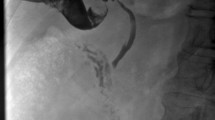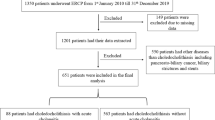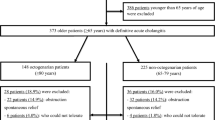Abstract
The prevalence of cholangitis and choledocholithiasis increases with age in all populations. Age-related changes have relevant implications in the diagnosis and management of these conditions. In this chapter, we examine the peculiarities of choledocholithiasis and acute cholangitis in the elderly. As for most acute abdominal conditions, the risk of erroneous or delayed diagnosis is high in aged patients, due to their clinical characteristics and age-related changes in the physiological responses to sepsis and inflammation. The higher risk that age and frailty imply stresses the importance of less invasive techniques for the clearance of the common bile duct obstruction. We examine the literature’s best evidence about the management of these conditions in the older adults. We also analyze the role of minimally invasive surgery in the treatment of the clinical conditions of the frailer and older patients.
Access this chapter
Tax calculation will be finalised at checkout
Purchases are for personal use only
Similar content being viewed by others

References
Shaffer EA. Gallstone disease: epidemiology of gallbladder stone disease. Best Pract Res Clin Gastroenterol. 2006;20:981–96.
Nassar Y, Richter S. Management of complicated gallstones in the elderly: comparing surgical and non-surgical treatment options. Gastroenterol Rep. 2019;7:205–11.
Isayama H, Yasuda I, Tan D. Current strategies for endoscopic management of acute cholangitis. Dig Endosc. 2017;29(Suppl 2):70–7.
Agrusa A, Romano G, Frazzetta G, et al. Role and outcomes of laparoscopic cholecystectomy in the elderly. Int J Surg. 2014;12(Suppl 2):S37–9.
Agarwal N, Sharma BC, Sarin SK. Endoscopic management of acute cholangitis in elderly patients. World J Gastroenterol. 2006;12:6551–5.
Khashab MA, Tariq A, Tariq U, et al. Delayed and unsuccessful endoscopic retrograde cholangiopancreatography are associated with worse outcomes in patients with acute cholangitis. Clin Gastroenterol Hepatol. 2012;10:1157–61.
Collins C, Maguire D, Ireland A, et al. A prospective study of common bile duct calculi in patients undergoing laparoscopic cholecystectomy: natural history of choledocholithiasis revisited. Ann Surg. 2004;239:28–33.
Laurell H, Hansson L-E, Gunnarsson U. Acute abdominal pain among elderly patients. Gerontology. 2006;52(6):339–44.
Hu KC, Wang HY, Chang WH, et al. Clinical presentations of patients from different age cohorts with biliary tract stone diseases. J Gastroenterol Hepatol. 2014;29:1614–9.
Hu K-C, Chu C-H, Wang H-Y, et al. How does aging affect presentation and Management of Biliary Stones? J Am Geriatr Soc. 2016;64(11):2330–5. https://doi.org/10.1111/jgs.14481.
ASGE Standards of Practice Committee, Maple JT, Ikenberry SO, Anderson MA, et al. The role of endoscopy in the management of choledocholithiasis. Gastrointest Endosc. 2011;74:731–44.
Manes G, Paspatis G, Aabakken L, et al. Endoscopic management of common bile duct stones: European Society of Gastrointestinal Endoscopy (ESGE) guideline. Endoscopy. 2019;51:472–91.
Iida T, Kaneto H, Wagatsuma K, et al. Efficacy and safety of endoscopic procedures for common bile duct stones in patients aged 85 years or older: a retrospective study. PLoS One. 2018;13(1):e0190665. https://doi.org/10.1371/journal.pone.0190665.
Saito H, Koga T, Sakaguchi M, et al. Safety and efficacy of endoscopic removal of common bile duct stones in elderly patients ≥90 years of age. Intern Med. 2019;58(15):2125–32. https://doi.org/10.2169/internalmedicine.2546-18.
Narula VK, Fung EC, Overby DW, et al. Clinical spotlight review for the management of choledocholithiasis. Surg Endosc. 2020;34:1482–91.
Lee A, Min SK, Park JJ, et al. Laparoscopic common bile duct exploration for elderly patients: as a first treatment strategy for common bile duct stones. J Korean Surg Soc. 2011;81(2):128–33. https://doi.org/10.4174/jkss.2011.81.2.128.
Alexakis N, Connor S. Meta-analysis of one- vs. two-stage laparoscopic/endoscopic management of common bile duct stones. HPB (Oxford). 2012;14(4):254–9.
Dasari BV, Tan CJ, Gurusamy KS, Martin DJ, et al. Surgical versus endoscopic treatment of bile duct stones. Cochrane Database Syst Rev. 2013;9:CD003327.
Shojaiefard A, Esmaeilzadeh M, Ghafouri A, et al. Various techniques for the surgical treatment of common bile duct stones: a meta review. Gastroenterol Res Pract. 2009;2009:840208. https://doi.org/10.1155/2009/840208.
Clayton ESJ, Connor S, Alexakis N, et al. Meta-analysis of endoscopy and surgery versus surgery alone for common bile duct stones with the gallbladder in situ. Br J Surg. 2006;93(10):1185–91.
Poulose BK, Arbogast PG, Holzman MD. National analysis of in-hospital resource utilization in choledocholithiasis management using propensity scores. Surg Endosc. 2006;20(2):186–90.
Rojas-Ortega S, Arizpe-Bravo D, Marin Lopez ER, et al. Transcystic common bile duct exploration in the management of patients with choledocholithiasis. J Gastrointest Surg. 2003;7(4):492–6.
Thompson MH, Tranter SE. All-comers policy for laparoscopic exploration of the common bile duct. Br J Surg. 2002;89(12):1608–12.
Wu X, Huang Z-J, Zhong J-Y, et al. Laparoscopic common bile duct exploration with primary closure is safe for management of choledocholithiasis in elderly patients. Hepatobiliary Pancreat Dis Int. 2019;18(6):557–61.
Zheng C, Huang Y, Xie E, et al. Laparoscopic common bile duct exploration: a safe and definitive treatment for elderly patients. Surg Endosc. 2017;31(6):2541–7.
Zhu J, Tu S, Yang Z, et al. Laparoscopic common bile duct exploration for elderly patients with choledocholithiasis: a systematic review and meta-analysis. Surg Endosc. 2020;34(4):1522–33.
Shen F, Pawlik TM. Surgical management of choledocholithiasis: a disappearing skill. JAMA Surg. 2016;151(12):1130–1.
Wandling MW, Hungness ES, Pavey ES, et al. Nationwide assessment of trends in choledocholithiasis management in the United States from 1998 to 2013. JAMA Surg. 2016;151(12):1125–30.
Ansaloni L, Pisano M, Coccolini F, et al. WSES guidelines on acute calculous cholecystitis. World J Emerg Surg. 2016;11:25.
van Dijk AH, de Reuver PR, Besselink MG, et al. Assessment of available evidence in the management of gallbladder and bile duct stones: a systematic review of international guidelines. HPB. 2017;19(4):297–309.
McAlister VC, Davenport E, Renouf E. Cholecystectomy deferral in patients with endoscopic sphincterotomy. Cochrane Database Syst Rev. 2007;(4):CD006233.
Xu J, Yang C. Cholecystectomy outcomes after endoscopic sphincterotomy in patients with choledocholithiasis: a meta-analysis. BMC Gastroenterol. 2020;20(1):229.
Khan MA, Khan Z, Tombazzi CR, et al. Role of cholecystectomy after endoscopic sphincterotomy in the management of choledocholithiasis in high-risk patients: a systematic review and meta-analysis. J Clin Gastroenterol. 2018;52(7):579–89.
Gomi H, Takada T, Hwang TL, et al. Updated comprehensive epidemiology, microbiology, and outcomes among patients with acute cholangitis. J Hepatobiliary Pancreat Sci. 2017;24(6):310–8. https://doi.org/10.1002/jhbp.452.
Park CS, Jeong HS, Kim KB, et al. Urgent ERCP for acute cholangitis reduces mortality and hospital stay in elderly and very elderly patients. Hepatobiliary Pancreat Dis Int. 2016;15(6):619–25. https://doi.org/10.1016/s1499-3872(16)60130-3.
Kiriyama S, Kozaka K, Takada T, et al. Tokyo guidelines 2018: diagnostic criteria and severity grading of acute cholangitis (with videos). J Hepatobiliary Pancreat Sci. 2018;25:17–30.
Kiriyama S, Takada T, Strasberg SM, et al. New diagnostic criteria and severity assessment of acute cholangitis in revised Tokyo guidelines. J Hepatobiliary Pancreat Sci. 2012;19:548–56.
Gomi H, Solomkin JS, Schlossberg D, et al. Tokyo guidelines 2018: antimicrobial therapy for acute cholangitis and cholecystitis. J Hepatobiliary Pancreat Sci. 2018;25:3–16.
Mukai S, Itoi T, Baron TH, et al. Indications and techniques of biliary drainage for acute cholangitis in updated Tokyo guidelines 2018. J Hepatobiliary Pancreat Sci. 2017;24(10):537–49.
Day LW, Lin L, Somsouk M. Adverse events in older patients undergoing ERCP: a systematic review and meta-analysis. Endosc Int Open. 2014;2(1):E28–36. https://doi.org/10.1055/s-0034-1365281.
Zhu B, Li D, Ren Y, et al. Early versus delayed laparoscopic common bile duct exploration for common bile duct stone-related nonsevere acute cholangitis. Sci Rep. 2015;5:11748. https://doi.org/10.1038/srep11748.
Gholipour C, Shalchi RA, Abassi M. Efficacy and safety of early laparoscopic common bile duct exploration as primary procedure in acute cholangitis caused by common bile duct stones. J Laparoendosc Adv Surg Tech A. 2007;17(5):634–8.
Atstupens K, Plaudis H, Fokins V, et al. Safe laparoscopic clearance of the common bile duct in emergently admitted patients with choledocholithiasis and cholangitis. Korean J Hepatobiliary Pancreat Surg. 2016;20(2):53–60.
Jia B, Jin Z, Han W, et al. Safety and efficacy of emergency laparoscopic common bile duct exploration in elderly patients with complicated acute cholangitis. Surg Endosc. 2020;34(3):1330–5.
Author information
Authors and Affiliations
Editor information
Editors and Affiliations
Rights and permissions
Copyright information
© 2021 The Author(s), under exclusive license to Springer Nature Switzerland AG
About this chapter
Cite this chapter
Perrone, G. et al. (2021). Cholangitis and Choledocholithiasis. In: Agresta, F., Podda, M., Campanile, F.C., Bergamini, C., Anania, G. (eds) Emergency laparoscopic surgery in the elderly and frail patient. Springer, Cham. https://doi.org/10.1007/978-3-030-79990-8_8
Download citation
DOI: https://doi.org/10.1007/978-3-030-79990-8_8
Published:
Publisher Name: Springer, Cham
Print ISBN: 978-3-030-79989-2
Online ISBN: 978-3-030-79990-8
eBook Packages: MedicineMedicine (R0)



